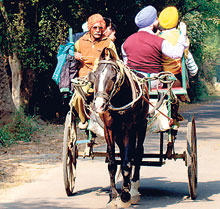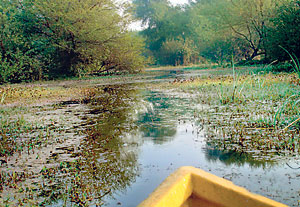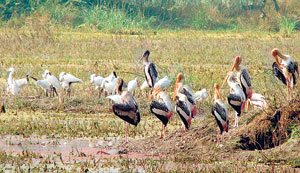Dawn is breaking amidst bird calls and mist hanging in the chill air. Our boat silently glides along the waterway.
On either side is jungle. We see the shadowy image of a male Nilgai Antelope (also called the Blue Bull), wading and nibbling the tender leaves of the trees overhanging the water. It goes on eating unconcerned by our approach.
But the grazing Spotted Deer gallop off through the water, making a noisy retreat. This is Keoladeo National Park, formerly the Bharatpur Sanctuary in Rajasthan, North India.
We drift further downstream and the mist is like a cloud of smoke. When we talk, we send out puffs of frosty air. On either side of the waterway are trees, some hanging down to the water. Other weeds and plants grow along with algae.
Dewdrops hang precariously on leaves like diamonds, glinting in the first rays of the sun. It is still extremely cold and we are glad of our monkey caps and sweaters as the boat snakes its way through the misty forest. With the aid of a long stick, the boatman skilfully and silently takes us on this journey. We are accompanied by our guide Ramesh Gupta.
 |
| A horse-drawn carriage gives visitors a leisurly ride through the park |
On the trees are thousands of nesting painted storks and Ibis. The fledglings of the painted storks remain in the nests while the parents fly to and fro with food for them. There is always a big commotion from the fledglings and parents bringing food and trying to feed the young.
Soon we are out of the boat and walking along the pathways.
As we walk around, we discover scoreboards of sorts, on concrete tablets. Recorded are the tally of ducks which had been shot in one day and the names of the marksmen. Among the highest was British Governor General Lord Linlithgow who had shot 4273 ducks here in 1938 in one single day! After much lobbying by nature lovers, the Wild Life Act of 1972 prohibited shooting wild life in India.
The park is 29 square km and consists of shallow lakes and woodland, with pathways made of paved brick and forest trails for people to wander around. About 400 species of birds can be seen here, making it a paradise for bird watchers. Keoledeo is said to be having one of the finest heronries in the world. Numerous paths and trails interconnect and Babul trees dominate the park, providing shade. There are ample opportunities to quietly sit and watch birds from the many concrete garden seats alongside every path. Serene and tranquil, it is the ideal place for undisturbed bird watching or for cycling along the leafy pathways.
The water bodies are full of fish and thus water birds abound. The woodland attracts the other varieties of birds. As many as 2000 Painted Storks are spotted sometimes breeding here. White Ibis, Open bills, Spoonbills, Egrets, Herons, Cormorants, Shags are plentiful. Thousands of Moorhens and Jacanas are found in the water bodies. In October, in come the winter migrants like Gadwal, Wigeon, Shoverlers, Garganey, Marbled, Common and Nothern Pintails – red-crested, common and white-eyed Pochards.
We watch the Spot Billed ducks in the water and some on the embankment under the shade of a tree while on the other side of the trail on a mossy green patch with tall reeds a Marsh Harrier is flitting about.
Our guide also takes us on a quick seven kilometre drive in an electric car to a spot where pair of Sarus Cranes is feeding. They are a wonderful sight, standing 6 feet tall (2 metres) with a wing span of 8 feet (2.4 metres).
 |
| The boat silently glides along the waterway |
This is a resident bird, snowy white with the head and neck area in crimson. There are only a few of them around and thus it is only the guides who know the exact place where they can be spotted.
Bicycle rickshaws taking two persons at a time, are frequent. We sit perched a few feet above ground level, as if we are silently floating through the park. We pass other rickshaws coming in the opposite direction, with men and women in bright coloured clothes. The men especially look grand in the traditional North Indian turban and sharwani all in the same colours of blue, yellow, green, purple and even pink. Some ride in horse carts too as there is a road that runs through the park.
Our guide hails us to a stop from his rickshaw and we follow him on a footpath into the undergrowth. He points under a bush and to our surprise there coiled neatly and fast asleep is a huge Rock Python.
We are soon sailing by in the rickshaw observing flocks of birds and passing water where jacanas and other water fowl are to be seen.
Then again Ramesh makes us alight from the rickshaw and this time on a faraway tree, through the binoculars we sight three Egyptian Vultures. A short distance more and Ramesh points to a palm tree and snugly sitting on a branch huddled together are some Spotted Owlets.
Some of the winter migratory birds that come here are the Buntings, Flamingos and the much sought after Siberian Crane. Then there are the Steppe Eagle, Greater spotted Eagle, Pale and Marsh Harriers, Osprey and the Peregrine Falcon. Among the Indian species are the Tawny Eagle, Ring-tailed Eagle, Brahminy and black-winged kites and the King or Black Vultures. The civet cat, jungle cat, fishing cat and even the leopard have been spotted here.
Being able to walk long stretches in the wooded shady sanctuary, amidst the birds and the occasional Nilgai grazing unperturbed was balm to my soul and blissful for all of us nature-loving people.
Its History
- The sanctuary was created 250 years ago and is named after a Keoladeo (Shiva) temple within its boundaries.
- In 1745 a natural depression was flooded after the Ajan bund was constructed by Maharaja Suraj Mal, the then ruler of the princely state of Bharatpur. The bund was created at the confluence of two rivers, the Gambhir and Banganga.
- It attracted waterfowl from distant places. This was made into a reserve and number of sluice gates were installed, creating a shooting ground for the Maharaja of Bharatpur. It was actually the private property of the Maharaja of Bharatpur which was declared the Bharatpur Sanctuary in 1982. It was upgraded to the Keoladeo National Park a few years ago.
- In 1982, grazing was banned in the park, leading to violent clashes between the local farmer and Gujjar communities and the government.
|




